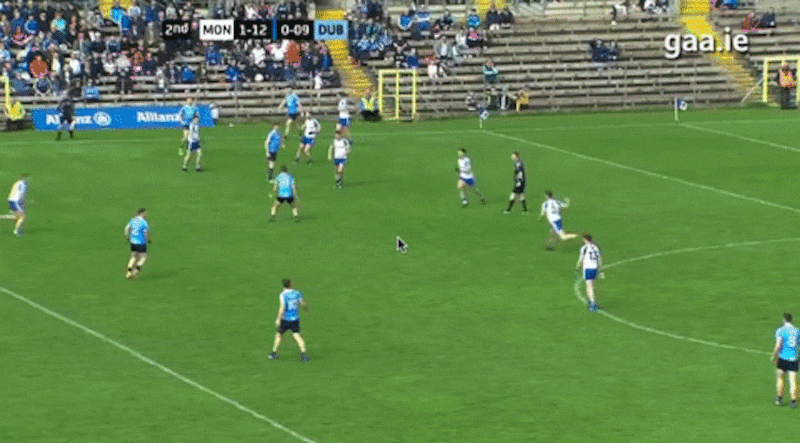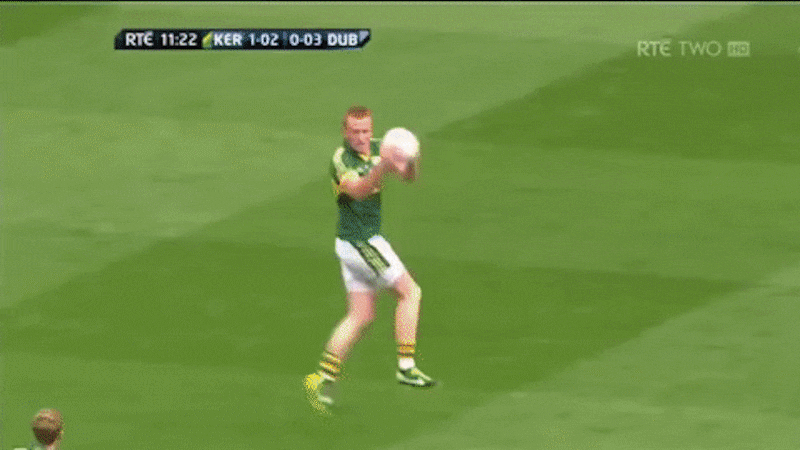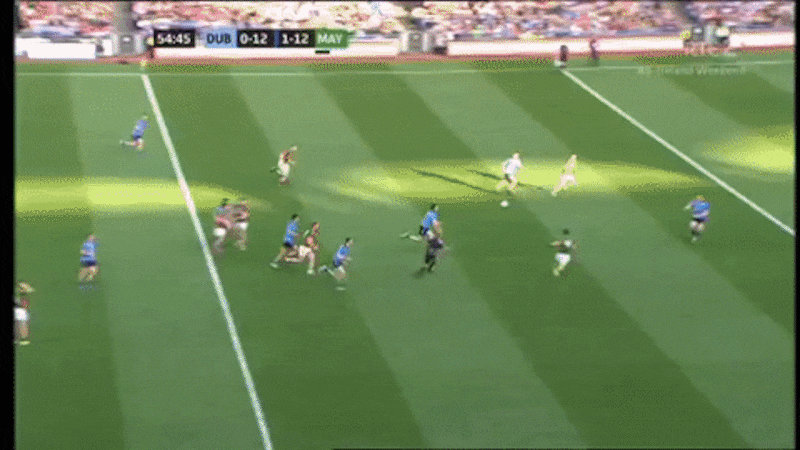If Monaghan supporters watching Dublin coolly construct the goals that sunk them in Clones last Sunday felt as if they had somehow seen it all before, that’s because they had.
Up 1-12 to 0-9 after 48 minutes, the home team were, until that moment, in a brilliant position to complete the coup of the season. The worst of it is that when the Monaghan squad review the film this week, they will see how avoidable both Dublin’s goals were.
When Ciarán Kilkenny took possession of the ball just inside the 50, four Monaghan players stood between him and their goalposts. There was no immediate danger when Kilkenny looked up to see what was on.
Had the Monaghan players just stayed put, the chances are that Kilkenny would have looked to move the ball on and find a different point of attack. But by needlessly rushing up on the ball, two Monaghan defenders gave Kilkenny the chance to accelerate through the gap they left even as they came towards him.
Nobody laid a finger on him. He couldn’t believe his luck as he carried the ball unmolested towards Rory Beggan’s goal, he was straight through.
Bernard Brogan was, at this stage, to be found in the very same place as when Monaghan played Dublin in the All-Ireland quarter final of 2014: hanging tight on the edge of the small parallelogram, showing for the ball to the left of the goalposts and just watching and waiting until his marker was forced to commit, when he knew the pass would come to him.

Karl O’Connell was the Monaghan defender marking Brogan; he felt he had no choice but to close down Kilkenny, who instantly slipped the hand-pass to one of the most ruthless finishers in the game. It looked like the training ground move that it was – one that Dublin have rehearsed a thousand times.
The goal was strikingly similar to the one Brogan scored against Monaghan in the 27th minute of that 2014 championship game.

In that move, when James McCarthy took possession, he lobbed a kick pass out to the wing and immediately accelerated to take the return pass that he knew was coming. The Dublin player who gave him that return pass had nothing else on his mind.
Last option
There is still no cause for immediate Monaghan panic as McCarthy takes the ball again. Three Monaghan defenders were moving towards McCarthy to close the ball down. But this is exactly what Dublin want. There is no better team in Gaelic football at exploiting the habit of ball-watching.
So as McCarthy moves forward, Monaghan corner-back Colin Walsh, who is marking Brogan, is mesmerised by the sight of Dublin's athletic half-back advancing with the ball and decides to play help defence.
As soon as Walsh steps forward, Brogan makes a back door cut behind him and shows for the ball with his inside hand. McCarthy knows where to look for him and Brogan knows the pass is coming. That’s because they’ve practiced this thousands of times at training.
With that, Monaghan's fate is sealed. McCarthy now has the full attention of three Monaghan players and has the strength and accuracy to get his hand-pass away even as Dick Clerkin and Stephen Gollogly make the tackle.
You can be sure that the last option the Monaghan coaching staff would ever want to concede is a one-on-one goal chance to Bernard Brogan. But that’s exactly what happens.
Brogan is free as a bird when he takes the ball and the scoring chance is bread-and-butter for a finisher of his calibre.
Dublin have been using McCarthy is this role for years so it was no surprise that he was the supplier for the goal that killed Monaghan off last week. Monaghan had 14 men in their own 45 when Jack McCaffrey took possession again on the left wing where Dublin have worked their most significant scores in recent years.
Everyone in the ground knew what McCaffrey wanted to do; find a Dublin team-mate to pass to and then accelerate to look for the return. And that’s what happened.
It was breathtakingly simple. The player McCaffrey found with the ball was James McCarthy. The significant thing is that as soon as McCarthy took possession, every Monaghan player in the picture is looking at the man with the ball.
Original runner
It’s as though McCaffrey has been forgotten about. And the Clontarf man knows this. He still has a fair bit of ground to cover but he’s a flier and you can see him adjusting his run behind Monaghan’s Ryan Wylie, who actually tears past McCaffrey to join the Monaghan pack converging on McCarthy. McCaffrey visibly changes his line of running to create an angle for the pass.
The only person on the field tracking McCaffrey for those vital three seconds is James McCarthy. Four Monaghan men are now entirely involved in preventing whatever scoring threat is presented by McCarthy.
The trouble is that in this instance, he isn’t even thinking about the Monaghan goal posts. His role here is to supply the ball to the original runner. His fisted pass is exceptional, bouncing straight ahead of McCaffrey so that he doesn’t have to adjust his stride in taking possession.
The finish is clinical, heartbreaking and the speed and crispness of the move creates the illusion that Dublin are an unstoppable force of nature. And it kind of disguises the truth which Monaghan doubtlessly flogged themselves with this week: one of the stickiest and smartest defensive units in the game allowed two Dublin players to cut through their defence with two hand-passes. They were all caught watching the ball. They were suckered.
This isn’t to hammer Monaghan. Dublin have been thriving on the naivety of elite defenders throughout the country for the past four summers. You could pick any number of examples.
Dublin probably learned from themselves. In a week when the tributes sung for Colm Cooper, there was much talk of the Killarney man's visionary kick passes for two of the Kerry's goals in the celebrated 2013 semi-final against Dublin.
What the Dublin coaches probably remember is how Donnchadh Walsh, involved in a necklace of passes around the perimeter of the Dublin defence, was then allowed to run completely unmarked from the Dublin 45 deep into their defensive D. Everyone was watching Cooper. Everyone was watching the ball, in other words – except for Cooper, who was watching Walsh.

Once Walsh had the ball, the Dublin defenders were helpless. They had been outdone. By ball watching. They don’t cough those kinds of goals up anymore. The teams they play against do.
First goal
In the All-Ireland semi-final replay of 2015, Mayo led Dublin by 1-12 to 0-11 after 53 minutes. Dublin have managed just one score in the second half when James McCarthy bangs over a point from distance.
That's why the concession of the first goal would have infuriated Mayo when they studied the film later. Just 45 seconds after McCarthy's point, Paddy Andrews chips a pass from dead centre of the Mayo 45 to Alan Brogan, who is 30 metres out from goal on the right. As Brogan takes possession, Brian Fenton is trailing behind the ball. There are three Mayo defenders a good 10 metres back on him.
The trouble begins for Mayo even as the ball leaves Andrews foot and travels to Brogan. Fenton is one of four Dublin players moving across the 50. Macauley is covered by a Mayo defender but as the ball travels, the two Mayo players covering the front of the D follow it, first with their eyes and then turning themselves to face Brogan. It's instinctive and understandable but it's also counter-productive. Colm Boyle is the closest player to Brogan and is well placed to guard him.
Once Fenton spots that both Mayo players have turned, he accelerates, ghosting behind them and taking a hand pass from Alan Brogan in a staggering amount of space.
When Fenton takes the ball, Bernard Brogan is to be found in the very same place as he was against Monaghan in 2014 and again last Sunday: loitering with intent on the edge of the left of the small square, leaving his marker between a rock and a hard place.

In this, Brendan Harrison does the smart thing: he sticks with Brogan and forces Fenton to beat Clarke with his shot. Fenton actually skews his shot and it could have gone anywhere but it skids across and Brogan sticks a foot out for a goal. It's the kind of goal for which the fullback line gets skewered on The Sunday Game. But in truth, the fault lay in the decision making when the ball was out on the 50.
Same trick
Ninety seconds later, Mayo are caught out with the same trick, again along the left flank which has been richly rewarding for Dublin. Ciarán Kilkenny passes to Bernard Brogan, who does what he always does: squares his body in order to square his defender, feints with the ball to go inside and then tries to beat his marker on the outside. Harrison recovers and shepherds Brogan towards the end-line, with help from another defender. As Brogan receives the ball, Philly McMahon, who will score the goal, is just mooching, like a man out for a Sunday morning jog in the Phoenix Park.
There are four Mayo jerseys around McMahon and Colm Boyle is in the heart of the Mayo square. The problem is that everyone is looking at Brogan, who has the ball. Nobody notices Philly and Philly notices them not noticing.
Even as Brogan tries to beat Harrison on the outside, he has the immediate attention of two tacklers, the general attention of Aidan O’Shea and (possibly) Kevin McLoughlin who are jogging towards Brogan with no sense that the real danger is trailing them on the inside. Had they only turned their heads for a second, one of them could have picked up McMahon.
Fatally, Colm Boyle’s attentions have also been drawn towards Brogan and he starts to move to help out his team-mates. Noticing this, McMahon begins to move at speed, his inside hand showing and he is moving towards the Mayo goal. He is all alone. Nobody even sees him.
Did Brogan see him even as he ditched the ball with his (arguably thrown) pass which looped over goalkeeper Rob Hennelly for McMahon to palm home into an empty net? Possibly he saw a flash of blue shirt but even if he didn’t he would have guessed that Dublin would have a runner steaming through the middle. Because they work at that, over and over. Now its 2-12 to 1-12 in the 57th minute and the Dubs are on their way again.
When the teams met in the 2016 final, you can see Mayo have learned their lesson. Eight minutes in and Dublin are scoreless. When Brian Fenton makes a break down the left flank (once again), Mayo are alive to the player steaming through the centre; both Harrison and McLoughlin flank Bernard Brogan.
But the mistake has already been made as after laying-off the ball, Fenton was allowed to run unmarked into an ocean of space. Everyone was watching the ball. Mayo were unlucky that Fenton’s shot and Brogan’s stab ended in an own goal. But you make your own luck.
Beating Dublin has become an outrageously tough proposition for the best of teams. But the league and All-Ireland champions must be delighted by how frequently other defences rush to the ball and forget about everyone else – until it’s too late.












